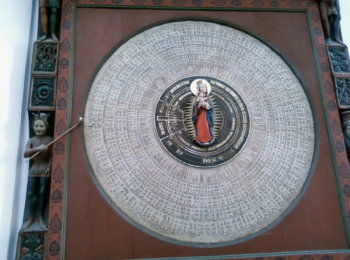
15th century rotating dial clock face, St. Mary's Church, Gdansk, Poland.
Clocks existed before clock faces. The first mechanical clocks, built in 13th century Europe, were striking clocks: their purpose was to ring bells upon the canonical hours, to call the public to prayer. These were erected as tower clocks in public places, to ensure that the bells were audible.
The word clock from the Latin word clocca, bell
, suggests that it was the sound of bells which
also characterized the prototype mechanical clocks that appeared during the 13th century in Europe.
It was not until these mechanical clocks were in place that their creators realized that their wheels could be used to drive an indicator on a dial on the outside of the tower, where it could be widely seen.
Before the late 14th century, a fixed hand (often a carving shaped like a hand) indicated the hour by pointing to numbers on a rotating dial; after this time the current convention of a rotating hand on a fixed dial was adopted. Minute hands (so named because they indicated the small or minute divisions of the hour) only came into regular use around 1690, after the invention of the pendulum and anchor escapement increased the precision of time-telling enough to justify it.
A mercury clock, described in the Libros del Saber
, a Spanish work from A.D. 1277 consisting of translations and
paraphrases of Arabic works, is sometimes quoted as evidence for Muslim knowledge of a mechanical clock.

Mechanical clock showing the escapement which controls the escape
of power from the spring or weight.
Between 1280 and 1320, there is an increase in the number of references to clocks in church records, and this probably indicates that a new type of clock mechanism had been devised. Existing clock mechanisms that used water power were being adapted to take their driving power from falling weights. This power was controlled by some form of oscillating mechanism, probably derived from existing bell-ringing or alarm devices.
This controlled release of power - the escapement - a device that (1) transfers energy to the timekeeping element and (2) enables counting the
number of oscillations of the timekeeping element. It is the source of the ticking
sound in watches and clocks
marks the beginning of the true mechanical clock.

A scale model of Su Song's Astronomical Clock Tower, built in 11th century Kaifeng, China. It was driven by a large waterwheel, chain drive, and escapement mechanism.
Outside of Europe, the escapement mechanism had been known and used in medieval China, as the Song Dynasty engineer Su Song (1020 - 1101) incorporated it into his astronomical clock-tower of Kaifeng in 1088.
However, this clock still relied on the use of flowing water (i.e. hydraulics), while European clockworks of the following centuries shed this old method for a more efficient driving power of weights, in addition to the escapement mechanism.
A working escapement is invented in about 1275. The process allows a toothed wheel to turn, one tooth at a time, by successive teeth catching against knobs projecting from an upright rod which oscillates back and forth.
The speed of its oscillation is regulated by a horizontal bar (known as a foliot) attached to the top of the rod. The time taken in the foliot's swing can be regulated by moving weights in or out on each arm.
The function of the foliot is the same as that of the pendulum in modern clocks, but it is less efficient in that gravity is not helping it to oscillate. A very heavy weight is needed to power the clock, involving massive machinery and much friction.
With escapements, chiming mechanisms and dials, clocks are now set to evolve into their more familiar selves. The telling of time soon alters people's perceptions of time itself. Hours, minutes and seconds are units which only come into existence as the ability to measure them develops.
